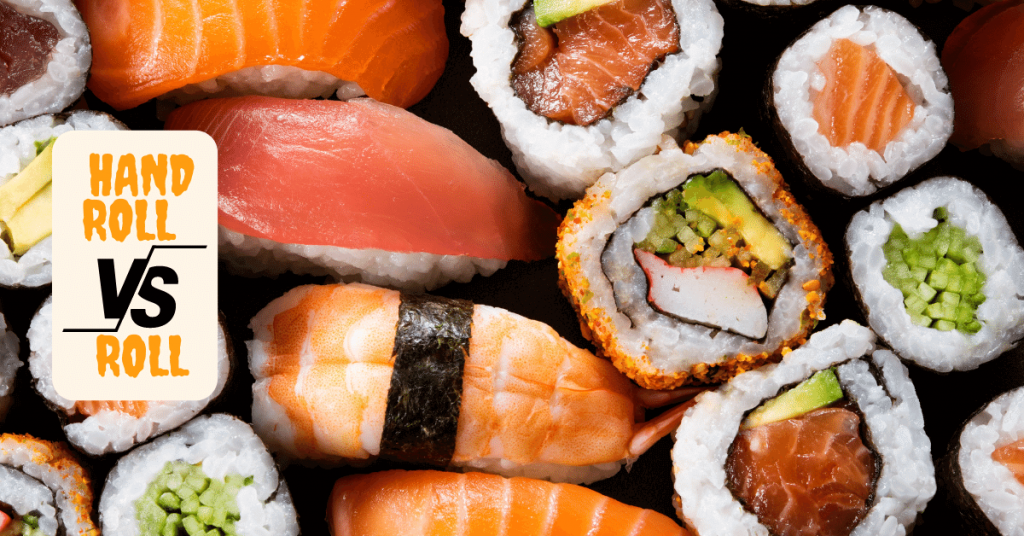It’s no secret that when it comes to sushi, there are many different ways to enjoy it. Some people like to eat it with their hands, while others prefer to use chopsticks. And then there are those who like to roll their own sushi rolls. But what’s the difference between hand rolls and rolled sushi? Let’s take a closer look.

Hand rolls are sushi that is rolled by hand, using a sheet of nori (seaweed) to wrap the ingredients. This method is often used for smaller rolls, as it’s easier to control the amount of filling. Hand rolls are also typically served with the seaweed on the outside, which some people prefer.
Rolled sushi, on the other hand, is made using a bamboo mat. The ingredients are placed on a sheet of nori, and then the whole thing is rolled up tightly. This method results in a larger, more uniform roll. Rolled sushi is often served with the seaweed on the inside, which some people prefer because it’s less messy.
So, which is better? It really depends on personal preference. Some people prefer the taste and texture of hand rolls, while others find rolled sushi to be more convenient. Ultimately, it’s up to you to decide which type of sushi you prefer.
What is a hand roll?
A hand roll is a type of sushi that is rolled by hand, using a sheet of nori (seaweed) to wrap the ingredients. This method is often used for smaller rolls, as it’s easier to control the amount of filling. Hand rolls are also typically served with the seaweed on the outside, which some people prefer.
What is rolled sushi?
Rolled sushi is made using a bamboo mat. The ingredients are placed on a sheet of nori, and then the whole thing is rolled up tightly. This method results in a larger, more uniform roll. Rolled sushi is often served with the seaweed on the inside, which some people prefer because it’s less messy.
What’s the difference between hand roll and classic roll sushi?
The main difference between hand roll and classic roll sushi is the way they are rolled. Hand rolls are rolled by hand, using a sheet of nori (seaweed) to wrap the ingredients. This method is often used for smaller rolls, as it’s easier to control the amount of filling. Hand rolls are also typically served with the seaweed on the outside, which some people prefer.
Rolled sushi, on the other hand, is made using a bamboo mat. The ingredients are placed on a sheet of nori, and then the whole thing is rolled up tightly. This method results in a larger, more uniform roll. Rolled sushi is often served with the seaweed on the inside, which some people prefer because it’s less messy.
What is the tastiest sushi?
The tastiest sushi is the kind that you like the best! Some people prefer the taste and texture of hand rolls, while others find rolled sushi to be more convenient. Ultimately, it’s up to you to decide which type of sushi you prefer.
What country eats the most sushi?
Although sushi originated in Japan, it has become popular all over the world. It’s difficult to say which country eats the most sushi, but it’s safe to say that there are many sushi lovers out there!
Is eating sushi with your hands rude?
Eating sushi with your hands is perfectly acceptable in many cultures. In fact, some people prefer it because it allows them to taste the sushi more fully. However, if you are eating sushi in Japan, it is considered polite to use chopsticks.
What is a California hand roll?
A California hand roll is a type of sushi that is rolled by hand, using a sheet of nori (seaweed) to wrap the ingredients. This method is often used for smaller rolls, as it’s easier to control the amount of filling. Hand rolls are also typically served with the seaweed on the outside, which some people prefer.
A California hand roll typically contains sushi rice, avocado, and crab meat. Some recipes also call for cucumber, tobiko (fish eggs), or other fillings.
What is sushi without rice called?
Sushi without rice is typically called sashimi. Sashimi is made with raw fish or other meats that have been cut into thin slices. It is often served with soy sauce, wasabi, and pickled ginger.



